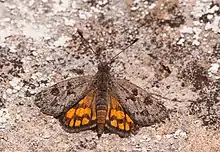| Synemon | |
|---|---|
 | |
| Synemon discalis | |
| Scientific classification | |
| Domain: | Eukaryota |
| Kingdom: | Animalia |
| Phylum: | Arthropoda |
| Class: | Insecta |
| Order: | Lepidoptera |
| Family: | Castniidae |
| Subfamily: | Castniinae |
| Tribe: | Synemonini |
| Genus: | Synemon Doubleday, 1846 |
| Species | |
|
See text | |
Synemon (commonly known as the Sun-moths) is a genus of moths within the family Castniidae. It was described by Edward Doubleday in 1846.[1] The genus contains 24 described and 20 undescribed species.[2] These species are found across mainland Australia and on Kangaroo Island, with the highest diversity in Western Australia.[2] Synemon species can be found in a range of habitats, including woodlands, heathlands and native perennial grasslands.[2] The adults fly during the daytime in warm to hot weather.[2] They have clubbed antennae, and are often mistaken for butterflies.[3]
Sun-moths typically have dull coloured forewings which, at rest, conceal their brightly coloured hindwings.[2] The hindwings can be used to startle potential predators.[3] All known larvae of sun-moths feed on monocotyledonous plants, such as Rytidosperma, Gahnia, Lepidosperma and Lomandra.[3] Since European settlement, many species have suffered drastic reductions in their distributions due to habitat loss from agriculture and other threats.[2] Some are listed as threatened, including Synemon plana, which is listed as critically endangered under the Australian Government Environment Protection and Biodiversity Conservation Act 1999.[4]
Species
The genus includes the following species:
- Synemon austera Meyrick, 1891
- Synemon brontias Meyrick, 1891
- Synemon catocaloides Walker, 1865
- Synemon collecta Swinhoe, 1892
- Synemon directa Westwood, 1877
- Synemon discalis Strand, 1911
- Synemon gratiosa Westwood, 1877
- Synemon heliopis Meyrick, 1891
- Synemon jcaria R. Felder, 1874
- Synemon laeta Walker, 1854
- Synemon leucospila Meyrick, 1891
- Synemon magnifica Strand, 1911
- Synemon maja Strand, 1911
- Synemon nais Klug, 1850
- Synemon notha Westwood, 1877
- Synemon nupta Westwood, 1877
- Synemon obscurella Westwood, 1877
- Synemon parthenoides R. Felder, 1874
- Synemon phaeoptila Turner, 1906
- Synemon plana Walker, 1854
- Synemon selene Klug, 1850
- Synemon sophia (White, 1841)
- Synemon theresa Doubleday, 1846
- Synemon wulwulam Angel, 1951
References
- ↑ "Synemon at funet.fi". Nic.funet.fi. 2005-09-24. Retrieved 2011-12-16.
- 1 2 3 4 5 6 Douglas, Fabian (January 2007). "THE SUN-MOTHS (LEPIDOPTERA:CASTNIIDAE) OF VICTORIA, WITH A DETAILED STUDY OF THE PALE SUN-MOTH (Synemon selene KLUG, 1850)" (PDF). Retrieved 6 April 2023.
- 1 2 3 McQuillan, P; Forrest, J; Keane, D; Grund, R (2019). CATERPILLARS, MOTHS AND THEIR PLANTS of southern Australia. Butterfly Conservation South Australia Inc. ISBN 978-0-646-80648-8.
- ↑ "Significant impact guidelines for the critically endangered golden sun moth (Synemon plana)" (PDF). 2009. Retrieved 6 April 2023.